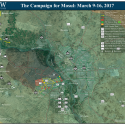 |
 |
The Campaign for Mosul: March 9-16, 2017

The Iraqi Security Forces (ISF) made significant progress from March 9 to 16, pushing deep into western Mosul and eliminating ISIS’s presence north of the city. ISIS has reopened attack fronts around Tikrit and Baiji, however, underscoring that Mosul’s recapture will not defeat ISIS in Iraq.
The Iraqi Security Forces (ISF) advanced towards the Old City in western Mosul from March 9 to 16, consolidating control over southwestern Mosul. The Federal Police and Emergency Response Division, an elite unit within the Ministry of Interior, inched into the Old City on March 11 along the Tigris River. The Counter Terrorism Service (CTS) meanwhile quickly established control over several southwestern neighborhoods and contact with the Old City on March 13. Northeast of the city, the 9th Iraqi Army Armored Division recaptured Badush Sub-District on March 15 and its environs. Across the river, units from the 16th IA Division recaptured remaining ISIS-held territory between Tel Kayyaf District and the western Peshmerga defensive line, including the Badush Dam facility on March 11. The facility, never finished, is the intended replacement for the eroding Mosul Dam.
The U.S. and Coalition will need to ensure their continued presence in Iraq after Mosul’s recapture, which could occur within a month, in order to clear remaining ISIS-held areas and ensure stability in recaptured areas. Coalition Spokesman Col. John Dorrian stated on March 15 that there should be an “enduring [force] requirement” beyond Mosul’s recapture, but that Coalition members would need to discuss any force posture with the Iraqi Government. These conversations should focus on short-term requirements for continuing anti-ISIS operations post-Mosul and the long-term training mission to ensure a local security force that can hold recaptured terrain. Both will require continued U.S. and Coalition support in order to sustainably defeat ISIS, prevent its resurgence, or security the country.
ISIS is reestablishing its network and capabilities between Baiji and Tikrit. The police chief of Baiji, an oil town recaptured from ISIS in October 2015, stated that extremists carried out forty “hit-and-run” attacks in Baiji in the last month alone. The police chief previously categorized attacks in the city as “rare.” Attacks around Baiji extend beyond simple hit-and-run tactics, however. Two SVESTs detonated at a wedding party south of Baiji on March 9, killing more than 20 people. ISIS executed members of the Albu Nimr tribe in Baiji and detonated an SVEST in a home south of the city on February 25. Both incidents underscore ISIS’s advanced technical ability and that ISIS either has a cell in Baiji or steady access to the area. Attacks in Tikrit have likewise increased, despite the high level of security provided by the ISF and militias. ISIS detonated a SVBIED in central Tikrit on March 15, one of the few attacks inside Tikrit City since its recapture in March 2015. ISIS has been reviving its capabilities east of Tikrit, particularly in al-Dawr, over the past three months. The attack inside Tikrit, however, suggests an advancement in ISIS’s capabilities in the area. Reviving and maintain these networks and capabilities could allow ISIS to maintain strength in Iraq even after it loses control of Mosul.